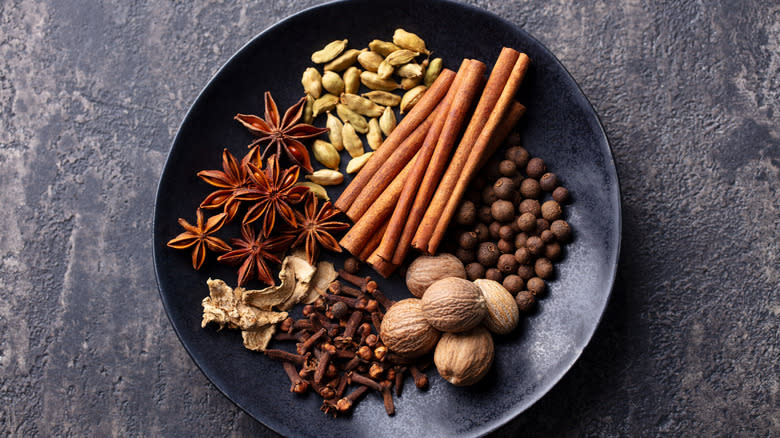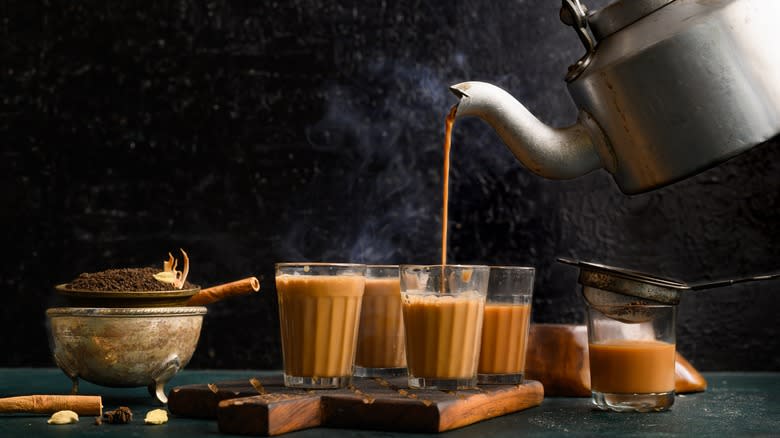Masala Vs. Irani Chai: What's The Difference?

If you're a fan of chai drinks, you may or may not know about the wide varieties of chai that exist around the world. You also may or may not know that "chai" translates to "tea" in Hindi, making the name "chai tea" a little redundant. The sheer popularity and rich history of chai in and outside of India means that most of us have a lot to learn about these sweet and spicy teas. There are thousands of varieties of chai out there, and none of them involve starting from concentrate like Starbucks' does.
From tulsi chai to Bombay chai, and from lebu chai to sulaimani chai, these teas have long been enjoyed all across East and South Asia and the Middle East. Each variation is representative of a different region, culture, or a combination of two. Some include milk, but others don't. Some are sweetened, and some are not. Some are made with green tea instead of black. And, some are made with two pots instead of one — at least, that's the case with Irani chai, the chai created by Persian settlers in India.
While Masala chai may be the first that people think of when they think of chai, there are a plethora of varieties that are symbolic of India's influence on other parts of the world — or vice versa. Irani chai is just one example.
Read more: 20 Tea Brands, Ranked From Worst To Best
What Is Masala Chai?

Masala chai dates back to over 5,000 years ago when Indian emperors are said to have first drank the steeped blend of spices and herbs known as chai masala, which includes green cardamom, nutmeg, ginger, cloves, star anise, and cinnamon. Back then, the drink was mostly used for the ayurvedic purposes and the medicinal origins of each spice. Masala chai didn't contain caffeine until the British colonization of India. In order to sustain the country's tea consumption, the British exploited the tea plants that grew in the northeastern state of Assam. But, that still doesn't explain how the tea was introduced to the chai masala spice concoction.
While the British drank plenty of black tea, the Indian people did not. To increase consumption in India, the British began to offer it to locals during work breaks. It didn't take long for them to start mixing it with the masala spices they'd been enjoying for years — offering both the ayurvedic health benefits and a healthy dose of probably much-needed caffeine. To make it more cost-effective, Indian people began using leftover tea leaves and mixing them with brewed milk, sugar, and masala spices, crafting masala chai as it's now known and enjoyed all over the world. Today, the drink is an emblematic part of Indian culture, and there are many variations of it. However, masala chai is thought to be the most authentic and true form.
What Is Irani Chai?

While masala chai is most significant in Indian culture, its influence knows no bounds. Still, some varieties of the tea were influenced by cultures outside of India. Irani chai is one of them. As you can probably guess from its name, Irani chai was introduced by Iranian settlers in India. Traveling from Iran to Mumbai, then to Pune, and finally to Hyderabad throughout the 19th and early 20th centuries, Iranian settlers applied the tea preparation methods from their homeland to the chai they found across India to create what is now known as Irani chai. Although it may not be the most popular style of chai broadly, it dominates Hyderabad and its many Irani cafés.
When tasting Irani chai, you may not notice much of a difference between it and other styles of Indian chai. Besides the occasional use of buffalo milk, which is sometimes substituted for a solid milk reduction known as khoya or mawa, it otherwise contains all of the same spices found in the chai masala blend. Some stories suggest that Irani chai was born from the get-togethers between Irani immigrants and Indians within Irani cafés. These cafés were so popular because of the traditional Iranian food they served. However, when it came to tea, they thought they should serve it the way the locals liked it. But, they still made the drink their own, and it's all in how it's prepared.
Irani Chai Is Prepared With Two Pots

While the settlers in India preserved their Iranian cuisine through the range of traditional pastries and foods offered in their cafés. At the same time, they also did what they could to ensure that the tea they offered met the preferences of the local population. This, of course, meant adding milk to their chai tea. While the type of milk used can vary from region to region, that's not what makes Irani chai different from the traditional Indian masala chai. Instead, it's the preparation that sets it apart.
Masala chai is usually prepared by simmering the spices, adding milk, and simmering some more. With Irani chai, the milk is actually simmered and warmed completely separately from the chai masala spice blend and the water. The two aren't combined until the tea is served. The separation allows for the chai masala to develop deeper, more substantial flavors, while also allowing the milk to thicken slightly. This produces a creamier and richer mouthfeel once the components are combined and ready to drink.
Irani Chai Is Thicker And Creamier

In the U.S., where oat milk chai lattes are especially popular, you can order tea with any variety of plant-based milk you like. But, with Irani chai specifically, it's either made with a solid milk reduction known khoya or mawa, fresh raw milk, condensed milk, milk powder, or evaporated milk, but the best is made with fresh, raw buffalo milk.
The reason that Irani chai made this way is considered the best is because fresh, raw buffalo milk has a higher concentration of fat than cow milk. As most baristas know, the fat concentration of milk has a direct correlation to its taste and texture when it has been steamed or frothed. Generally, a higher concentration of fat results in a creamier latte. In the case of Irani chai, the creamier it is, the better.
When served, it often comes with a thick layer of cream that's either clotted or pulled and naturally sweet. But still, in most cases, cow or plant-based milks work fine as substitutes for buffalo milk — and they're much easier to find in many places.
Masala Chai Is Much More Common

Even though Irani chai made with buffalo milk is considered the best, that doesn't really mean much if the only places you can get it are the Irani cafés across India — which are becoming fewer and farther between. In fact, even in Mumbai, the largest and most populated city in India, the number of Irani-owned cafés is dwindling, with less than 40 total locations by 2019. Hyderabad is said to be the destination to go to if you want to find authentic Irani chai made with buffalo milk specifically.
Unlike Irani chai, however, masala chai is a lot easier to get your hands on. As India's most popular drink, you can order it basically anywhere, whether you're in India or not. That being said, Indian masala chai tastes very different from the chai lattes you order from cafés in the U.S. Due to the process of steeping the milk along with the chai masala spices, you will find a much more pronounced sweet-and-spicy flavor. While each recipe generally begins with the same four spices, the recipe can still change from person to person.
The quality of ingredients, the spices used, and the preparation process all factor into how your masala chai might taste. Even if you can only get the best, most authentic masala chai in India or an Indian restaurant abroad, it is still much easier to come by than authentic Irani chai.
Masala Chai Flavors Are A Bit More Subdued

The preparation process of Irani chai results in slightly more prominent flavors. When you're making masala chai, the milk is added to the chai masala blend while it's steeping. If you make your own tea at home, and specifically if you drink your tea with milk, you may have noticed that if you use water and wait to add the milk until you actually serve your tea, you end up with a much stronger steep. So, while chai does pack the spicy flavors to stand out when steeped with milk, it will come out a bit stronger when it's made the Irani way.
That being said, an authentically made masala chai is likely to taste a lot stronger than the Starbucks chai you order. That's because those tend to be made by using a chai concentrate mixed with milk, rather than steeping the spices and herbs and then simmering the milk with them. The traditional way gives the spices time to fully infuse into the milk, rather than just mixing them together. But, even if masala chai does taste stronger than what you might be used to, it still won't taste quite as prominent as Irani chai.
Read the original article on Tasting Table.
